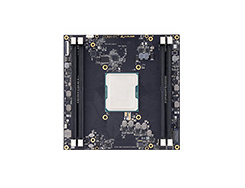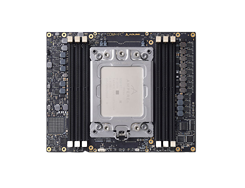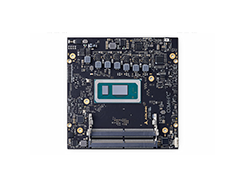
The need for a new specification to complement COM Express is easily explained: As a result of the digital transformation, the demand for embedded computers to provide high-speed performance is growing. To serve the new class of embedded edge servers, scalability must be limitless. With its 440 pins, COM Express does not have enough interfaces for powerful edge servers.
The performance of the COM Express connector is also slowly approaching its limits:
While COM Express can easily handle the 8.0 GHz clock speed and 8 Gbit/sec throughput of PCIe Gen 3, the verdict is still out regarding whether the connector meets certain technological advances such as PCIe Gen 4.
The COM-HPC® specification is intended to extend on the success of COM Express, not to replace it, and were officially released in Q1 of 2021.
COM-HPC® introduces significantly improvements with respect to COM Express (COMe):
• Significantly larger form factors on COM-HPC®
• Improved 800 pins Module-Carrier connector (440 max pins on COMe), capable of 32 Gtps (3x the bandwidth of COMe)
• Supports up to 8 full size DIMMs (up to 1 Tbyte) and up to 4 SO-DIMMs
• Higher power and larger Module CPUs (up to 150W supported, wrt 80W on COMe)
• More high speed interfaces are available:
– Up to 65 PCIe
– Up to 2x 10GBASE-T
– Up to 8x Ethernet KR interfaces at up to 25 Gbps
USB 3.1, USB 3.2 and USB 4.0 support
• More display interfaces may be supported:
– 3x DDI (DisplayPort or HDMI)
– 1x eDP
4x USB 4.0 DisplayPort mode
• Support for PCIe Targets:
– High end FPGA Modules
– GPU Modules
• Support for non x86 CPUs (i.e. ARM devices)
COM-HPC® introduces significantly improvements with respect to COM Express (COMe):
• Significantly larger form factors on COM-HPC®
• Improved 800 pins Module-Carrier connector (440 max pins on COMe), capable of 32 Gtps (3x the bandwidth of COMe)
• Supports up to 8 full size DIMMs (up to 1 Tbyte) and up to 4 SO-DIMMs
• Higher power and larger Module CPUs (up to 150W supported, wrt 80W on COMe)
• More high speed interfaces are available:
– Up to 65 PCIe
– Up to 2x 10GBASE-T
– Up to 8x Ethernet KR interfaces at up to 25 Gbps
USB 3.1, USB 3.2 and USB 4.0 support
• More display interfaces may be supported:
– 3x DDI (DisplayPort or HDMI)
– 1x eDP
4x USB 4.0 DisplayPort mode
• Support for PCIe Targets:
– High end FPGA Modules
– GPU Modules
• Support for non x86 CPUs (i.e. ARM devices)
As in COM Express architecture, COM-HPC® Standard requires the implementation of a compatible Carrier Board to bring out I/O and to Power Up the module.
As in COM Express architecture, COM-HPC® Standard requires the implementation of a compatible Carrier Board to bring out I/O and to Power Up the module.
COM-HPC® architecture defines 3 different types of module, based on the user needs and the application market:
1. Client Module Fixed Input Voltage
2. Client Module Wide Range Input Voltage
3. Server Module Fixed Input Voltage
Client Modules should not be used with Carrier Boards designed for Server Module, and Server modules should not be used with Carrier Boards designed for Client module.
COM-HPC® architecture defines 3 different types of module, based on the user needs and the application market:
1. Client Module Fixed Input Voltage
2. Client Module Wide Range Input Voltage
3. Server Module Fixed Input Voltage
Client Modules should not be used with Carrier Boards designed for Server Module, and Server modules should not be used with Carrier Boards designed for Client module.
The COM-HPC client module type targets use in high end embedded client products that need one or more displays, a full set of low, medium and very high bandwidth I/O for fast data transfer to support best-in-class peripherals, powerful CPUs and modest size. COM-HPC Client Type modules may host traditional x86 systems or alternative CPU architectures such as ARM64. While COM-HPC is primarily focused on x86 implementations, the standard supports heterogeneous architectures for specialized modules to improve performance and energy efficiency.
Client modules can operate with 2 different power sources: 12V fixed and Wide range input: 8V÷20V; Client modules accept up to 251W of power. CPUs with up to 100W dissipation are allowed with Wide range power input.
The range of applications for COM-HPC client type modules is very broad: medical equipment, test & measurement, rugged embedded computers, transportation systems and more.
Typical PCBs sizes:
Three different sizes of PCBs are recommended for client module use:
1. Size A (95mm x 120mm)
2. Size B (120mm x 120mm)
3. Size C (160mm x 120mm)
The COM-HPC specification currently defines two server modules. The largest of the server modules, Size E (200mm x 160mm), offers up to eight on-board DIMM sockets. The power input is a single 12-volt supply that can deliver up to 358 watts of power, and there are 64x lanes PCIe Gen5 in total.
The developers of many high-performance systems will also be interested to hear that COM-HPC server modules support the Intelligent Platform Management Bus (IPMB) and the Intelligent Platform Management Interface (IPMI). These are a set of computer interface specifications for an autonomous computer subsystem that provides management and monitoring capabilities independently of the host system’s CPU, firmware, and operating Server modules use the 12V fixed voltage input source and accept accept up to 358W of power(CPUs with up to 150W dissipation) over the 28 Module VCC pins.
The range of applications for COM-HPC Server Type modules is very broad: general purpose rugged embedded computer, mission critical server, stationery and mobile robotics, medical imaging and robotic surgery, test and measurement, and autonomous driving.
Typical PCBs sizes:
Two different sizes of PCBs are recommended for server module use:
1. Size D (160mm x 160mm)
2. Size E (200mm x 160mm)










